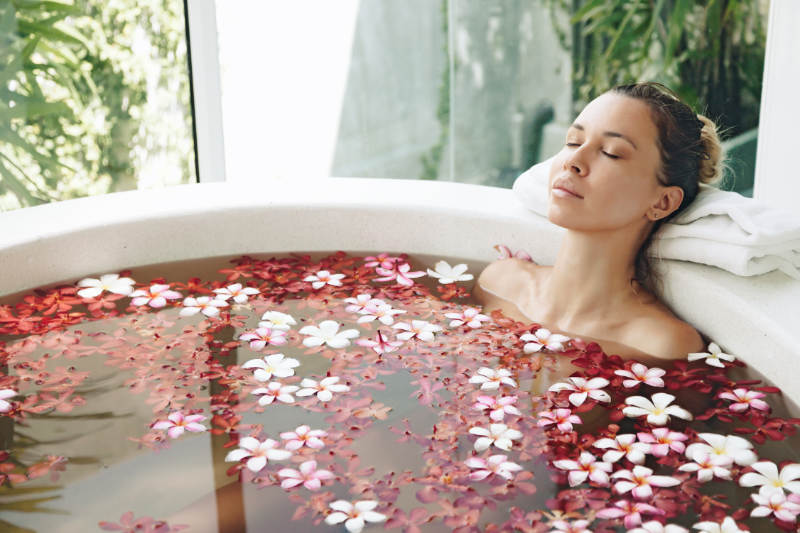Kati Snan or Hip Bath consists of submerging your lower body in a tub of water – this is a kind of hydrotherapy. It has various other names as well, such as steam baths, hip baths, spinal baths, cold body packs, and local compresses are all examples of how water is utilized in hydrotherapy. The goal is to increase blood flow to the tissues so that hazardous compounds may be dissolved and eliminated more easily.
Of the many kinds of hydrotherapy, kati snan, is among the most beneficial. For this, one needs a certain kind of bathtub. As the patient is seated in the tub, the water level is raised to cover their hips and reach just over their belly button.
Why should you take a Hip Bath?
Hip Bath has several health advantages. This method focuses just on the lower abdomen and hips, as the name says. Taking a soak in a bath like this is great for your body and mind. Symptoms of pelvic inflammatory disorders, including cellulitis, sciatica, and ovaritis, may be alleviated with this sort of hydrotherapy, so you can rest after a long day without worrying about your health. If you want to give yourself a proper kati snan, you need to make sure the water in the tub is high enough to cover your hips and belly button.
How to prepare for Hip Bath?
For Kati snan or Hip Bath, whether you want your water cold, warm, or hot is all up to you. For this, one needs a very specific kind of bathtub. When the patient is seated in the tub, the water level is adjusted such that it covers their hips and comes up to their navel. Typically, you’ll need between four and six gallons of water. Standard bathtubs may be substituted if the specialized tub is unavailable. Two or three inches of height may be added by placing a support beneath one side.
There are a variety of hip bath temperatures available, including cold, hot, neutral, and alternating. Hip baths are sometimes called sitz baths as well. It treats bladder, prostate, and vaginal infections, as well as lower-body pain and discomfort. Methods of action include maintaining a clean environment and improving blood flow to the injured region.
If you had to describe the Hip Bath, what would you say it looks like?
The oval form of the tub is both practical and aesthetically pleasing. The sufferer may lean his back against the raised end of the tub.
What are the Health Benefits of a Kati snan ?
– help new mothers recover faster
– Reduces swelling and disinfects the area to help prevent the spread of potentially hazardous infections.
– Possible use in eliminating toxins
– It has the potential to alleviate the discomfort of menstruation.
– As a bonus, it relieves haemorrhoids and bowel problems.
– Uterine cancer prevention and enhanced blood flow
– Improves the skin’s appearance.
– Perhaps useful in treating infertility
Pain associated with menstruation, difficult urination, a sore rectum or bladder, or painful piles may all be alleviated with a warm kati snan. It’s helpful for those with sciatica, ovarian and bladder neuralgia, and painful bladder contractions or spasms.
A cold Hip Bath may assist with issues like constipation, indigestion, and obesity by stimulating the elimination systems. Uterine issues such as menstrual irregularity, chronic uterine infection, pelvic inflammation, piles, hepatic congestion, chronic prostate gland congestion, seminal weakness, impotence, sterility, uterine and ovarian displacements, dilation of the stomach and colon, diarrhoea, dysentery, haemorrhage of the bladder, and so on can all benefit from its use.
All acute and sub-acute inflammatory disorders, including acute catarrh of the bladder and urethra and sub-acute inflammations in the uterus, ovaries, and tubes, may benefit from a neutral hip bath. To boot, it’s a calming remedy for ‘erotomanis’ in both genders. Salpingitis, ovaritis, cellulitis, and other genito-urinary neuralgias, as well as sciatica and lumbago, are among ailments that may benefit from regular Hip Baths.
Do’s and Dont’s
-It is recommended that you set the water temperature to your preferred level of comfort.
-Avoid staying in the hip bath for any longer than is necessary. Avoid doing this, since it will reduce the therapeutic benefits of the bath.
-If you have hypertension, you shouldn’t soak in a hot hip bath.
-After soaking your hips in warm water, it’s important to refresh with a cold shower or bath.
Post kati snan, Hip Bath Poses:
When you’ve finished your kati snan, take some time to sit quietly and concentrate on your breathing. To help you unwind during Savasana, the corpse posture is a great option after your hip bath.
Precautionary measures before taking a Hip Bath
To get the most out of these bathing treatments, it’s essential to follow some basic safety guidelines. Full-body washes should be avoided for at least three hours after eating and for at least an hour before. But, local baths like the Hip Bath and foot bath may be used after a meal if you wait at least two hours. One should always use fresh, clean water for bathing and never recycle bath water.
It’s important to take baths at the right temperature and for the right amount of time to feel their benefits. It is usually recommended to use a thermometer when taking a person’s temperature.
During menstruation, women shouldn’t use any of the baths. Until the third month of pregnancy is through, they can only take hip baths.
Thus, this was a detailed guide and insights into what kati snan is. As a therapy that has stood the test of time, you can be assured that this is exactly what you need in this modern time. The advantages of this therapy for your body and mind, as well as how to indulge in this experience seamlessly. Once you try this form of water therapy, you will begin to see the benefits for yourself.
For more blogs visit on our Nepal Yoga Home blog section.
